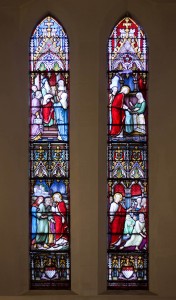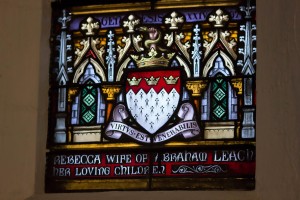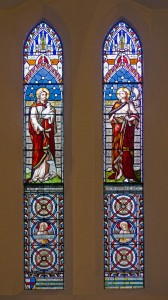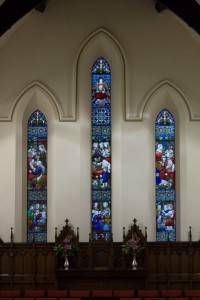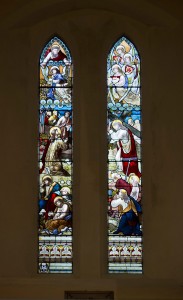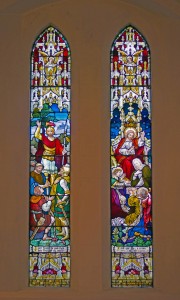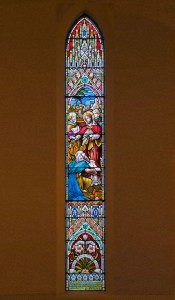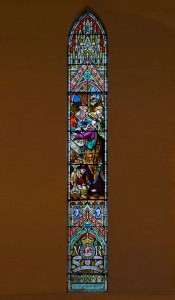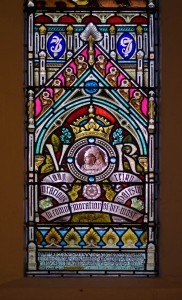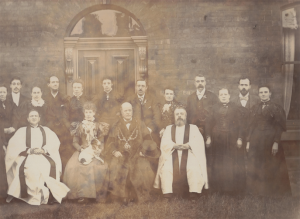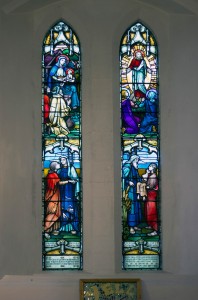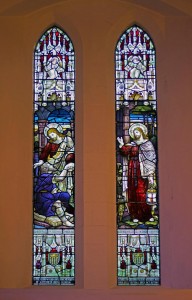When it was first built, the Church windows contained no stained glass. Today, most of them carry stained glass. With one exception, all the glass installed between 1871 and 1939.
The earliest window is the magnificent east window above the altar which is executed in a style that consciously evokes the medieval, and was installed 1871.
The windows are now treated in turn, starting with the window to the immediate left of the entrance porch. It may help to follow the map on page XX.
The Patrick Reynolds window
The Reynolds window, located by the south porch, bears the dedication, ‘To the memory of Revd. P.H. Reynolds, first vicar of the parish, 1845–1854. Died 1890.’ The window was made by R B Edmondson of Manchester and cost the then considerable sum of £81 8s, all of which was raised by public subscription. It was given by his friends to coincide with the church’s jubilee year in 1897.
Revd Reynolds was responsible for erecting the majority of the Church fabric. This window seems to reflect something of his amazing qualities. The lights on the left hand side show scenes from the life of Elijah: the upper one shows Elijah challenging King Ahab over his immoral leadership of Israel (1 Kings 18:18) and the lower one shows Elijah calling down fire from heaven to defeat the priests of Baal (1 Kings 18:39). The right hand panels show scenes from the life of John the Baptist: the upper light shows him preaching in the wilderness (Matthew 3:1) and the lower light shows him baptising Jesus (Matthew 3:17).
In his sermon during the window’s dedication, the Revd Gouldie French explained the choice of subject: ‘Christ is the true light, and His light ought to be seen in the lives of his followers. Elijah’s light was searchingly conspicuous, none the less so was that of the Baptist. The window on which are depicted scenes of the life of two such staunch and loyal servants of God is with very great propriety erected as a memorial to the first Vicar of this Parish’.
The Dr Abraham Leach window
This window is nearest to the front of the church on its south side. Its dedication reads, ‘To the glory of God and in memory of Abraham Leach, Surgeon, of Millfield House, Waterhead, who died April 21st, 1892. This window is erected by his loving children.’
The window was made by Comere and Capronnier of Brussels. The work of Jean-Baptiste Capronnier (1814–1891) was was greatly admired at the time. The date of this window’s installation means this was one of Capronnier’s last commissions. Another dated 1880 is unsigned but shows a very similar style; and further examples of Capronnier’s work can be seen nearby in Holy Trinity’s sister church, St John the Baptist, Hey or Lees.
The pictures were chosen to illustrate the various demands made on the skills of a medical practitioner, and are appropriately taken from the life of Jesus, the Great Physician. The upper lights show Jesus being presented in the Temple (Luke 2:27–39) and Jesus healing Peter’s mother-in-law (Matthew 8:14–16) while the lower panel shows first Jesus healing a lame man at the pool of Bethesda (John 5:1–9) then Jesus healing a man born blind (John 9:1–8). And, as the bearer of the coat of arms was a surgeon, the snake on top symbolises Asclepius, the Greek god of medicine.
Dr Abraham Leach
Signature of Abraham Leach
Dr Leach came to Waterhead in the early 1830s as a newly qualified doctor. He first set up his surgery in a cellar, but his reputation soon spread as both a physician and surgeon such that he soon acquired the spacious Millfield House and spent the remainder of his life there. Leach was a longstanding member of the Oldham Corporation (before 1972, the forerunner of Oldham Metropolitan Borough Council).
For example, in 1859 he became the first son of Waterhead to become Mayor of Oldham.
The coat of arms at the foot of the window bears his family motto ‘Virtus est venerabilis’ (Latin: ‘Virtue is worthy of great respect’). In fact, these arms were borne by one of Dr Leach’s ancestors, the fourteenth-century Sir John de Leche, who was court surgeon to King Edward III. Leach was also a generous benefactor of Waterhead Church.
Rebecca Leach window
The central window on the south side is dedicated to Rebecca Leach and was erected in 1880 ‘by her loving children’. Rebecca was the wife of Abraham Leach (above) and was also a faithful member of the Church. She and Abraham had eleven children, of whom only five were still alive when their father died aged 85. It was one of their daughters who unveiled the window dedicated to the first vicar.
The window tells the story of her namesake, the biblical Rebekah, who became Isaac’s wife. The window shows:
• Rebekah meeting Abraham’s servant at the well and providing water for the man and his camels (Genesis 24:18)
• The servant asking Rebekah’s father for her hand in marriage for his master’s son (Genesis 24:33–34)
• Rebekah accompanying the servant to Isaac’s house (Genesis 24:59)
and
• The marriage of Isaac and Rebekah, ‘And Isaac brought her into his mother Sarah’s tent, and took Rebekah and she became his wife; and he loved her’ (Genesis 24:67).
In common with the window to her husband Dr Abraham Leach, the Rebecca Leach window was made by Capronnier of Brussels.
The Francis Broadbent Window
Francis Broadbent was Waterhead’s second vicar (1855–1878). This window was dedicated in 1880 ‘In loving remembrance of Francis Buckley Broadbent, 23 years Vicar of Holy Trinity, Waterhead.’
This window comprises two panels. The left bears images of Jesus as the Good Shepherd and is accompanied by the verses ‘I am the Good Shepherd’ (John 10:11) and ‘As the Father knoweth me, so I the Father’ (John 10:15). On the right, we have Jesus ‘the resurrection and the life’, with the verses ‘Now is Christ risen from the dead, and is become the first fruit of them that sleep’ (1 Corinthians 15:20) and ‘I am the Resurrection and the Life’ (John 11:25).
The window was made by Edmondson and Son of Manchester and cost £50, which was paid for by the Parish.
The Chancel-arch window
This window was installed in 1934, and shows an image of Jesus accompanied by the words, ‘I am the true vine’ (John 15:5). He also holds a chalice, which holds wine—the fruit of the vine. This beautiful window looks especially glorious when the sun streams through it, but its height makes it difficult to see the detail. Even in the twenty-first century, cleaning the cobwebs from this window is remarkably complicated!
A small black-granite tablet was installed at eyelevel on the right-hand side of the chancel arch, and acts as the dedication to the window. It says, ‘The window over the chancel arch is in loving memory of John Lees and of Sarah Ann Lees his wife. Also of James Lee Andrew, and Ann Andrew. The gift of Martha Lees’.
A distinctive grave-stone on the south side of the churchyard remembers this same James Lee, and adds the detail that he died in Singapore on 15 November 1873, aged 26.
The Great East Window
The first stained glass window to be installed in Holy Trinity is the glorious east window above and behind the altar. The window was purchased (as a prize-winning entry) at the Paris Exhibition of 1870 and inserted in the Church in 1872.
The inscription at its base can no longer be seen owing to the upper reaches of the oak reredos which conceals the lowermost 10-inches or so of the window. But, suitably elevated, the inscription can be seen to read: ‘This window was erected by Edward Mayall, Mayor of Oldham in 1871, in affectionate remembrance of his Mother, who died in January 29th, 1842.’
Edward Mayall
Edward Mayall was born in 1824 into a family of cotton and coal mill-owners. He was the Church’s first People’s Warden. He was a local mill-owner and was known by his employees as a kind and considerate man. He was one of the first mill-owners in the village to grant the workers in his cotton mill a twelve-hour day and, every Wakes Week, he gave back the rents of his tenants so their children could have a treat. Every Christmas he gave a dinner for the old men of the village and when one of the men died during the festivities in January 1870, Edward insisted on paying the entire funeral expenses. One of his cotton mills, the ‘Lower Mill’ was on the site of what is now the Majestic Mill. He entered local politics in 1856 to become a councillor, then an alderman, and was elected Mayor of Oldham in 1870.
The Trinity
Christians believe in one God, but say he manifests himself in many ways. The most useful way of describing the way God acts in our World is to talk in terms of a Trinity made up of Father, Son and Holy Spirit. The concept of the Trinity is complicated and often described as a ‘mystery’. The Bible only hints at the Trinity as an idea or doctrine.
Christians say Father, Son and Spirit are each ‘persons’ of God. Each of these three persons is distinct. Within God, the three persons of the Trinity are completely melded together to the extent they become indistinguishable. So God is also one. In other words, there is one God who exists as three persons.
A simpler model of the Trinity uses the concept of love: the Father loves both the Son and Holy Spirit; the Son loves the Father and the Spirit; and the Spirit loves the Father and the Son.
Artists have always struggled to depict the Trinity. Most choose to depict the Father as an old man with a white beard, a young man with a darker beard as the Son, and a dove for the Spirit. The images at Waterhead Church follow this pattern. The Father appears most obviously near the top of the central panel of the Great East Window. Images of the Son (Jesus) appear almost everywhere in the windows. Images of the Spirit are more difficult to find. The most obvious can be seen in the Reynolds Window near the South Door where a dove hovers above Jesus at the moment of his baptism.
The tall central window represents the work of the Trinity to whom the church is dedicated. At the top is God the Father, then Jesus the Son, presenting a child to the disciples ‘and taking him in his arms, he said to them, ‘Whoever receives one such child in my name receives me; and whoever receives me, receives not me but the one who sent me.’ (Mark 9:36–37). At the bottom is the work of the Holy Spirit in a scene of healing, although the Spirit is not actually represented in any figurative sense—the usual choice is a dove. There is some question about which incident in the Bible this represents. Fred Lees, who wrote the original guidebook to the church, thinks it is St Paul visiting Lydia of Thyatira (Acts 16:14–16). Paul is traditionally shown carrying a book. However, the current writer thinks the subject may be St Peter raising Dorcas from the dead: the woman in the bed appears to be dead and the woman in the foreground could be one of the widows who stood around the body weeping ‘and showing coats and garments Dorcas had made [for the poor] while she was with them’ (Acts 9:36–end).
The maker of the central window remains wholly unknown, but it was certainly designed for Waterhead church because it incorporates Edward Mayall’s coat of arms into its design at the window’s bottom edge.
The right hand pane shows Jesus with the Samaritan Woman at the well (John 4:4–end). The lower illustration is the story of Jesus raising Jairus’ daughter from the dead (Matthew 9, Mark 5 and Luke 8).
The left hand pane shows the story of Mary and Martha. Jesus is speaking to Martha, (who is busy and annoyed that her sister is not helping her), and gesturing towards Mary, who sits at his feet listening to him. In Luke 10:40–42, Jesus chides Martha gently: ‘Mary has chosen the good portion, which shall not be taken away from her’. The lower illustration probably shows Jesus healing Simon Peter’s mother-in-law (Mark 1:30–31).
The Charles Shaw window
This is the small window to the left of the East window, between the chancel and the vestry. Vicar Shaw, as he was universally known, was a keen botanist and an expert in the field. It is therefore entirely appropriate that the window dedicated to his memory bears the inscription ‘Consider the lilies of the field’, and shows a cross emitting rays of light, with lilies growing beneath it. At its bottom lies the dedication, ‘In affectionate memory of Charles Edward Shaw, BA, MBE, FLS, Vicar 1957–1994.’
The Edward Mayall window
This window was erected in 1881 by Emma Mayall in memory of her husband Edward Mayall JP, who died on 21 June 1880, aged 56.
This two-light window has texts and illustrations. The left-hand window shows Jesus carrying his cross, watched by two women (probably Mary his mother and Mary Magdalene) and a Roman soldier. Three angels above his head bear symbols of the crucifixion: an image of the Lamb of God, a picture of the crown of thorns and the nails with which Christ was fixed to the cross, and the letters IHS, which stand for the name of Jesus (in Latin). The left-hand light shows the Garden of Gethsemane, with Peter, James and John asleep in the foreground, while Jesus prays and God sends an angel down to him with the cup of suffering he is about to drink. The two lights bear the texts that go with the illustrations: ‘The sacrifices of God are a broken spirit, a broken and contrite heart, O God, thou wilt not despise’ (Psalm 51:17), ‘Father, if Thou be willing, remove this cup from me’ (Luke 22:42) and ‘Surely he hath borne our griefs and carried our sorrows’ (Isaiah 53:4).
The Mayall family coat of arms appears faintly at the bottom far-left hand corner of the window, with the family motto Ne cede malis (‘Do not yield to misfortune’).
The John Schofield Window
This window was made by Mayer and Co. of Munich and London and installed in 1906. It bears the dedication ‘To the glory of God and in memory of John Schofield of Rose Hill, Waterhead, who died January 12th, 1905; and of Mary, his wife, who died April 29th 1895. This window was erected by their loving children’.
The window has one very unusual feature. The eastward of the two lights represents Christ teaching and urging his followers to be faithful even unto death. Before him are two angels and a woman with a white headdress who represents the late Mary Schofield.

The likeness of Mary Schofield from the window dedicated to her memory.
At the dedication of this window, the Vicar Gouldie French said of the window that the face was an excellent likeness of Mary herself. There is certainly a photographic quality to the image. The lilies around the feet of the figures symbolise purity and virtue, and the legend beneath the image says ‘I will give thee a crown of life’ (Revelation 2:10).
The left-hand window depicts the rebuilding of Jerusalem’s gate and wall by Nehemiah. Surrounded by armed men, Nehemiah is inciting them to ‘rise up and build’ (Nehemiah 13: 23–end).
John and Mary Schofield
The Schofield family were textile mill owners, owning the Rose Hill Mill. John Schofield was a young member of the congregation at ‘The Grove’ before the church was even built. It may have been his house in which the first preaching meetings occurred.
Schofield was Warden at the church for almost 40 years, a sidesman, Trustee of the Sick and Burial Society, and a Manager of the Day School for almost 40 years. He was a prominent member of the Committee which built the tower and spire in 1876; his name is on the plaque over the inner West door. He helped at the first extension of the schools in 1875 and again, when the infant school was erected in 1880. He also served Oldham as a Guardian to the Poor. His last public duty was to the inmates of Oldham Workhouse, for whom he had great concern. On 26 December 1904, he spent over 12 hours working there, and was exhausted when he returned home. In spite of rest and care, his health declined quickly and he died before the end of February.
His wife Mary Schofield was an active and dedicated member of the Ladies’ Committee and the committees for sales of work or bazaars. She also visited the sick and was as active in the church as women were then allowed to be.
Both remained members of Holy Trinity Church for the remainder of their long lives.
The Joseph Ellis Window
This is the left-hand light of the next two-light window on the north side, adjacent to the Victoria Window.
The window is dedicated ‘To the glory of God, and in loving memory of Joseph Ellis, born 1834, entered into rest 1895, for thirteen years head master of Waterhead National Schools, and teacher of the young men’s class in the Sunday School. This window is erected by his old scholars and friends, A.D. 1896.’
The picture represents the parable of the talents (Matthew 25) and in the middle are the words ‘Well done, thou good and faithful servant’. It is a fitting memorial to a teacher who worked faithfully for most of his life to develop the talents of his charges. The window was unveiled and dedicated at a special service on 10 January 1897.
The Queen Victoria Memorial Window
The photograph is located in the left-hand light of the window and was installed for Queen Victoria’s Diamond Jubilee.
The biblical illustration shows Queen Esther in the banquet scene where she risks her own life to intercede for the Jewish people (Esther 7:3). In the dedication address for the window, the vicar said ‘Esther was a woman well worthy of imitation; a modest, patriotic, religious and prudent Queen’ and added that Queen Victoria showed similar character traits. He was clearly an enthusiastic patriot: on another royal occasion he is reported to have said that ‘he ventured to think that there was, in the whole of the Kingdom, not a more loyal community than the parish of Waterhead’.
The Victoria Window
The Queen Victoria window at Waterhead is unique in the British Isles for it depicts a (then) reigning monarch in a Parish Church window in the form of a photographic image. We don’t know what process was used to produce the image, but the window clearly shows some degradation.
The window was installed to commemorate Queen Victoria’s Diamond Jubilee in 1897. The Church also celebrated its own Golden Jubilee the same year. The image is a near life-size bust of the elderly Queen, and bears the dedication ‘In commemoration of her most gracious Majesty’s long reign.’ Below the central image are the words, ‘To the Glory of God and as a permanent record of the 60 years reign of Queen Victoria. This window was erected by 895 loyal subjects at the Diamond Jubilee, 1897.’
The Jubilee Fund raised £167 7s 9d to finance the installation of this window. It was made locally by Edmondson and Sons of Manchester and unveiled by the Mayoress, Mrs Waddington, at a special service on the Sunday School Anniversary, 21 November 1897.
The unveiling committee of the Victoria Window on 21 November 1897.
The right-hand clergyman is Gouldie French while the other is the Curate, the Revd T. Wortley Hodson. Sitting between the two are the Mayor of Oldham and Mayoress. The Mayor in the year 1897–8 was a member of the congregation, Alfred Waddington. The other members in the photograph are currently unknown.
The Ben Harrop Window
This window is not in memory of Ben Harrop. Rather, he erected the window in 1904 to commemorate three people: Sarah Lees (probably the mother of Harrop’s wife, Mary); Mary Harrop herself; and their son William. It was executed by Reuben Bennett of Mount Clifton, Manchester.
The two upper illustrations depict scenes from the New Testament while the two lower images come from the Old.
The left-hand windows: the top panel shows the Nativity; below it is a scene from the Book of Ruth, where Ruth is telling her mother-in-law Naomi that she will not leave her: ‘Thy people shall be my people, and thy God my God’ (Ruth 1:16). The inscription reads: ‘To the glory of God, and in loving memory of Sarah Lees, of Waterhead, who died December 1st 1893, aged 61 years.’ The illustration from Ruth is therefore intended to illustrate the loyalty and love shown by the Harrops for their respective mother and mother-in-law.
The right-hand window: the top image shows the Resurrection, with Jesus rising in a halo of light as witnessed by the two Marys who look at him with awe. The lower panel shows the death of the Shunamite’s son in 2 Kings 4. In the story, the child collapses and his father is telling the servant to ‘Carry him to his mother’ (2 Kings 4:19). The child subsequently dies and is raised to life by the prophet Elisha. The inscription reads, ‘To the glory of God, and in loving memory of Mary , the wife of Ben Harrop, of Waterhead, who died December 9th, 1903, aged 73 years; also of their son William, who died December 4th, 1883 aged 17 years’. Presumably, then, the lower scene intends to convey the idea of the boy and his mother being united in heaven after death, while the juxtaposition of these two scenes is a strong expression of the family’s hope of the resurrection for them both.
Ben Harrop was another stalwart of Holy Trinity. His name can be seen on the plaque above the inner door of the old West porch, which records the names of those connected with the building of the tower and spire in 1976.
The Harries-Jones window
This window commemorates Llewellyn Golyddan Albert Harries-Jones, who was born in Llanfairfechan and described in the 1891 census as a solicitor living in the Hollinwood area of Oldham. He does not appear in the 1901 census. He was People’s Warden at Holy Trinity at the same time as John Schofield (whose memorial window is described above). He died unexpectedly on a trip to Eastbourne at the early age of 42. At his funeral, he was described as ‘one upon whose generous sympathy, sound judgement, and ever-ready personal and material co-operation we had learned to rely.’
The window was erected by his widow within a year of his death. Its dedication reads, ‘To the glory of God, and in loving memory of Llewellyn Golyddan Albert Harries-Jones, of Waterhead House, Oldham. Born July 16th, 1863. Died October 16th, 1905.’
The left-hand window shows Jesus healing a crippled man beside the pool of Bethesda and telling him: ‘Rise, take up your pallet and walk’ (John 5:8).
The right-hand light is a fine example of the stained glass makers’ art. It was made by Heaton, Butler and Bayne of Covent Garden in London and clearly follows Holman Hunt’s famous painting ‘The Light of the World’. But it is not a slavish copy for Jesus wears a crown of thorns in Hunt’s painting but in this window he is crowned with a halo; in the Hunt painting, the doorway is choked with briars and thorns but here the plants growing round the door are elegant meadowsweet which may here symbolise God’s grace. The cedars of Lebanon in the top right-hand corner of the window also depart from Hunt’s painting and may symbolise Harries-Jones’ uprightness and strength of character. The text indicated by the angel above the picture is ‘Behold, I stand at the door and knock’ (Revelation 3:20).
The Edward Pearson Window
Edward Pearson was Waterhead’s fifth Vicar (1933–1937). He died in office. His memorial was paid for by public subscription and installed in 1939. It comprises four windows in the west wall: two tall single lights, one on either side of the doorway, and over it two half-lights. All are of plain glass except the Pearson window itself, which is on the south side. It is located near the original site of the old stone font, and shows Mary with the infant Jesus. Its dedication reads, ‘In Memory of Edward Edmund Pearson, Vicar of this Parish 1933–1937’.
The style of the window differs from the glass in the nave, for it is realised in a manner contemporary with Pearson himself, and made famous by the English watercolourist Cicely Mary Barker (1895–1973). The main image is the Virgin Mary with the baby Jesus. The image is doubly apt: firstly, because the mother and child are/were located by the font and secondly because it was Pearson’s wife who formed the Mother’s Union at Holy Trinity during his time as Vicar.
The window has several unusual features: wild flowers grow near the feet of the mother and child and above their heads (in the tiny panes of clear glass) are four motifs, each in a separate small panel. These motifs represent the crib in which Jesus was laid, and the three gifts brought to him by the wise men, of gold, incense and myrrh.

